ELECTRONIC RETAILING Electronic Retailing Name of the University Author
VerifiedAdded on 2023/04/24
|12
|3461
|391
AI Summary
Contribute Materials
Your contribution can guide someone’s learning journey. Share your
documents today.
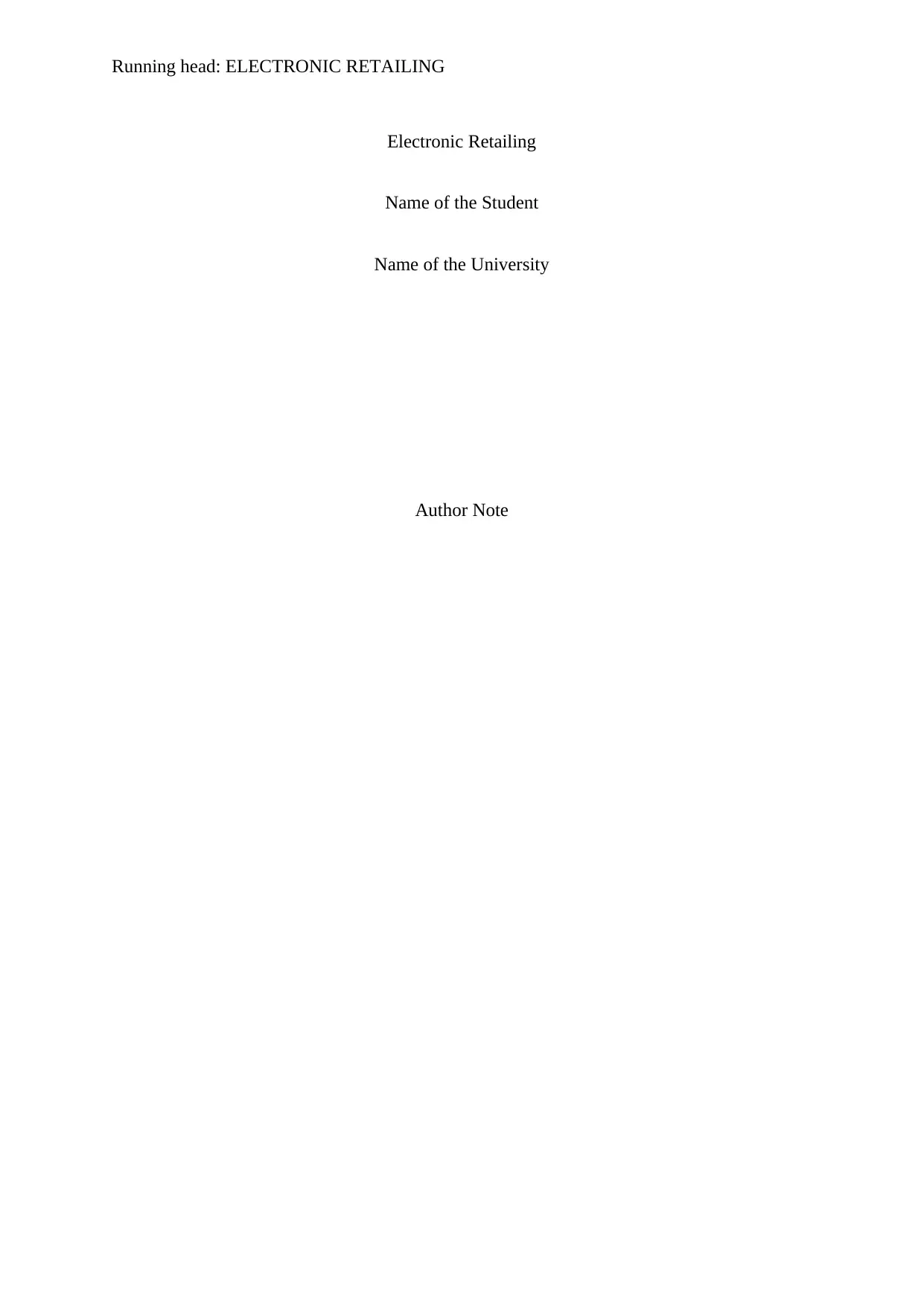
Running head: ELECTRONIC RETAILING
Electronic Retailing
Name of the Student
Name of the University
Author Note
Electronic Retailing
Name of the Student
Name of the University
Author Note
Secure Best Marks with AI Grader
Need help grading? Try our AI Grader for instant feedback on your assignments.
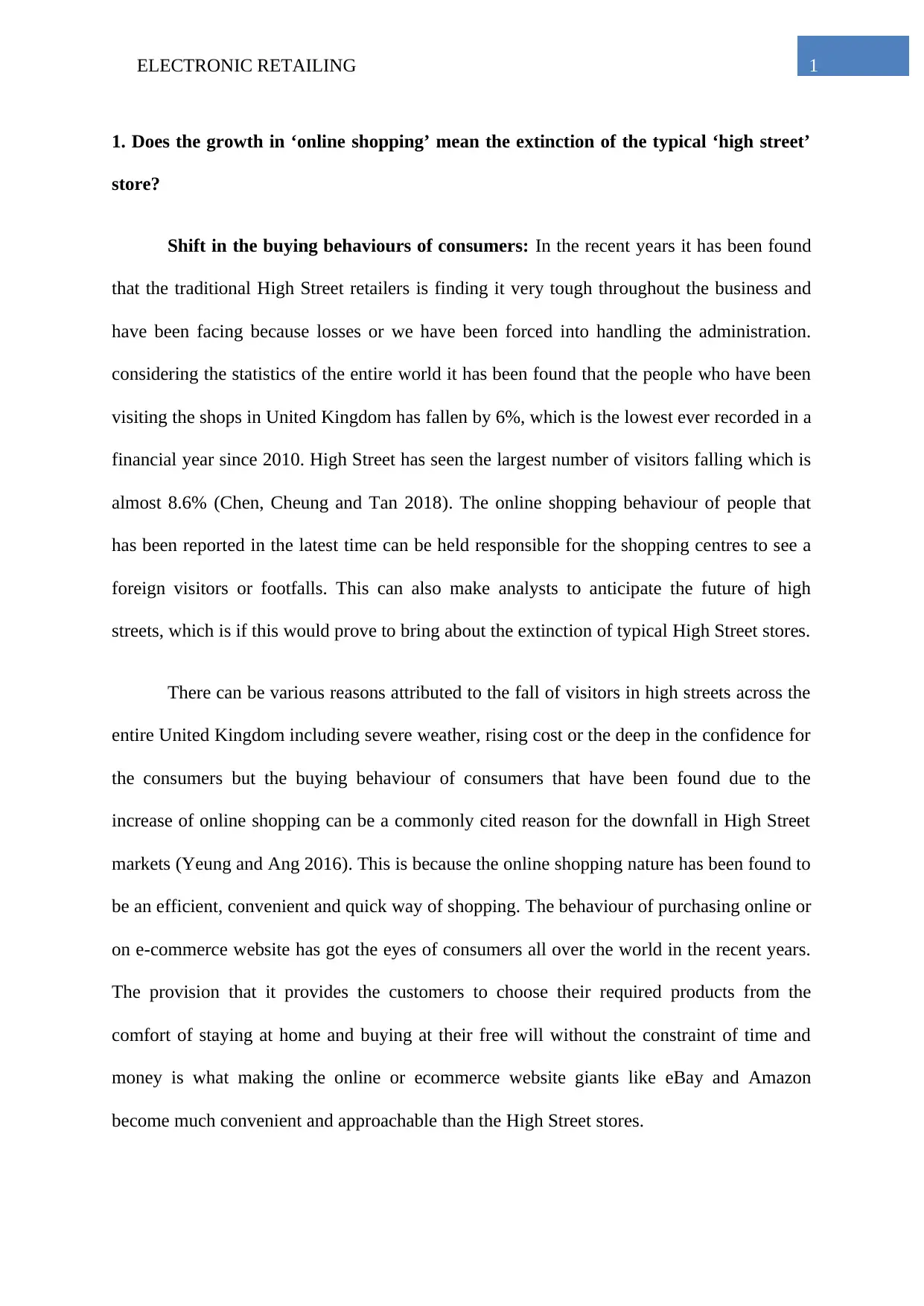
1ELECTRONIC RETAILING
1. Does the growth in ‘online shopping’ mean the extinction of the typical ‘high street’
store?
Shift in the buying behaviours of consumers: In the recent years it has been found
that the traditional High Street retailers is finding it very tough throughout the business and
have been facing because losses or we have been forced into handling the administration.
considering the statistics of the entire world it has been found that the people who have been
visiting the shops in United Kingdom has fallen by 6%, which is the lowest ever recorded in a
financial year since 2010. High Street has seen the largest number of visitors falling which is
almost 8.6% (Chen, Cheung and Tan 2018). The online shopping behaviour of people that
has been reported in the latest time can be held responsible for the shopping centres to see a
foreign visitors or footfalls. This can also make analysts to anticipate the future of high
streets, which is if this would prove to bring about the extinction of typical High Street stores.
There can be various reasons attributed to the fall of visitors in high streets across the
entire United Kingdom including severe weather, rising cost or the deep in the confidence for
the consumers but the buying behaviour of consumers that have been found due to the
increase of online shopping can be a commonly cited reason for the downfall in High Street
markets (Yeung and Ang 2016). This is because the online shopping nature has been found to
be an efficient, convenient and quick way of shopping. The behaviour of purchasing online or
on e-commerce website has got the eyes of consumers all over the world in the recent years.
The provision that it provides the customers to choose their required products from the
comfort of staying at home and buying at their free will without the constraint of time and
money is what making the online or ecommerce website giants like eBay and Amazon
become much convenient and approachable than the High Street stores.
1. Does the growth in ‘online shopping’ mean the extinction of the typical ‘high street’
store?
Shift in the buying behaviours of consumers: In the recent years it has been found
that the traditional High Street retailers is finding it very tough throughout the business and
have been facing because losses or we have been forced into handling the administration.
considering the statistics of the entire world it has been found that the people who have been
visiting the shops in United Kingdom has fallen by 6%, which is the lowest ever recorded in a
financial year since 2010. High Street has seen the largest number of visitors falling which is
almost 8.6% (Chen, Cheung and Tan 2018). The online shopping behaviour of people that
has been reported in the latest time can be held responsible for the shopping centres to see a
foreign visitors or footfalls. This can also make analysts to anticipate the future of high
streets, which is if this would prove to bring about the extinction of typical High Street stores.
There can be various reasons attributed to the fall of visitors in high streets across the
entire United Kingdom including severe weather, rising cost or the deep in the confidence for
the consumers but the buying behaviour of consumers that have been found due to the
increase of online shopping can be a commonly cited reason for the downfall in High Street
markets (Yeung and Ang 2016). This is because the online shopping nature has been found to
be an efficient, convenient and quick way of shopping. The behaviour of purchasing online or
on e-commerce website has got the eyes of consumers all over the world in the recent years.
The provision that it provides the customers to choose their required products from the
comfort of staying at home and buying at their free will without the constraint of time and
money is what making the online or ecommerce website giants like eBay and Amazon
become much convenient and approachable than the High Street stores.
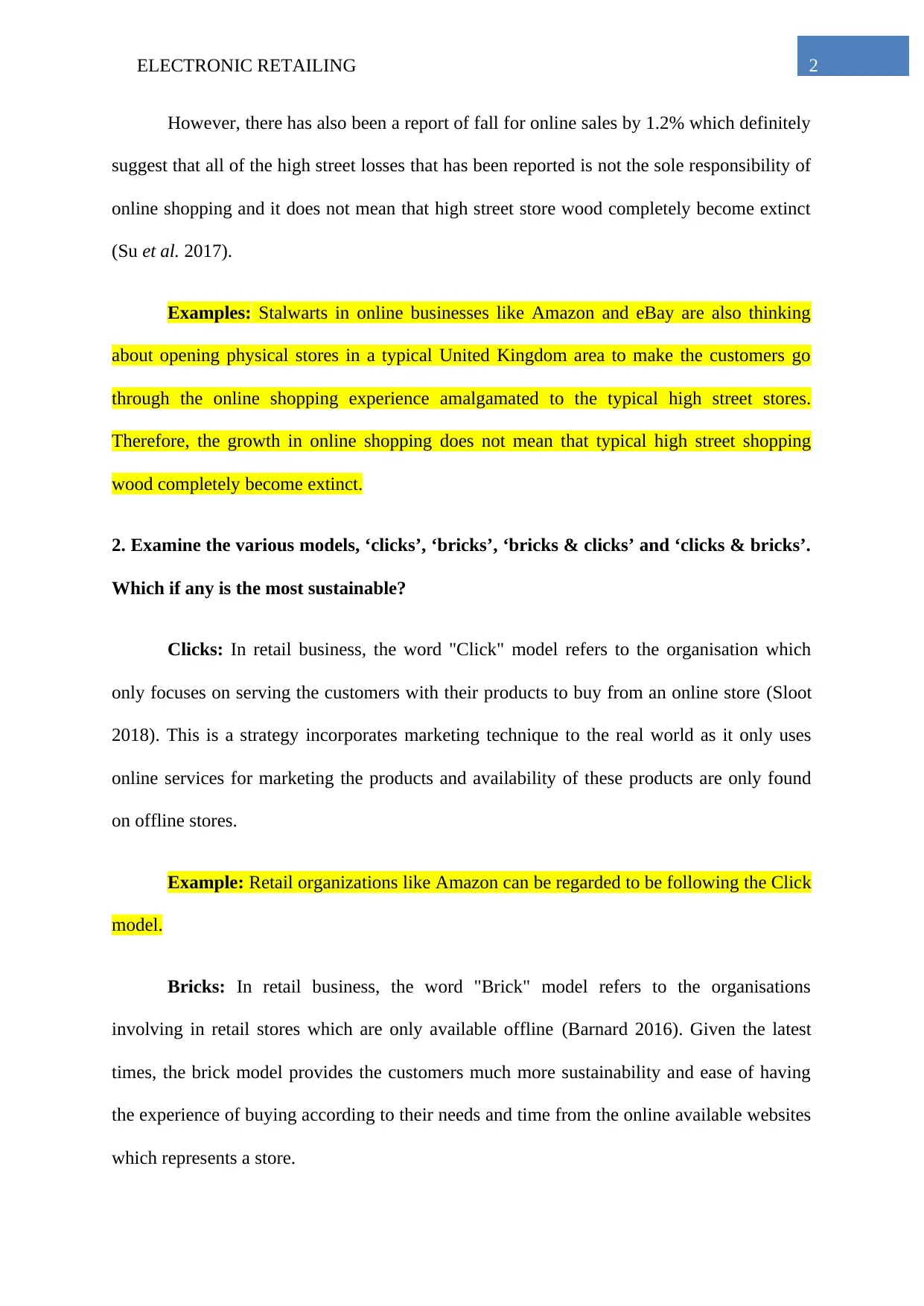
2ELECTRONIC RETAILING
However, there has also been a report of fall for online sales by 1.2% which definitely
suggest that all of the high street losses that has been reported is not the sole responsibility of
online shopping and it does not mean that high street store wood completely become extinct
(Su et al. 2017).
Examples: Stalwarts in online businesses like Amazon and eBay are also thinking
about opening physical stores in a typical United Kingdom area to make the customers go
through the online shopping experience amalgamated to the typical high street stores.
Therefore, the growth in online shopping does not mean that typical high street shopping
wood completely become extinct.
2. Examine the various models, ‘clicks’, ‘bricks’, ‘bricks & clicks’ and ‘clicks & bricks’.
Which if any is the most sustainable?
Clicks: In retail business, the word "Click" model refers to the organisation which
only focuses on serving the customers with their products to buy from an online store (Sloot
2018). This is a strategy incorporates marketing technique to the real world as it only uses
online services for marketing the products and availability of these products are only found
on offline stores.
Example: Retail organizations like Amazon can be regarded to be following the Click
model.
Bricks: In retail business, the word "Brick" model refers to the organisations
involving in retail stores which are only available offline (Barnard 2016). Given the latest
times, the brick model provides the customers much more sustainability and ease of having
the experience of buying according to their needs and time from the online available websites
which represents a store.
However, there has also been a report of fall for online sales by 1.2% which definitely
suggest that all of the high street losses that has been reported is not the sole responsibility of
online shopping and it does not mean that high street store wood completely become extinct
(Su et al. 2017).
Examples: Stalwarts in online businesses like Amazon and eBay are also thinking
about opening physical stores in a typical United Kingdom area to make the customers go
through the online shopping experience amalgamated to the typical high street stores.
Therefore, the growth in online shopping does not mean that typical high street shopping
wood completely become extinct.
2. Examine the various models, ‘clicks’, ‘bricks’, ‘bricks & clicks’ and ‘clicks & bricks’.
Which if any is the most sustainable?
Clicks: In retail business, the word "Click" model refers to the organisation which
only focuses on serving the customers with their products to buy from an online store (Sloot
2018). This is a strategy incorporates marketing technique to the real world as it only uses
online services for marketing the products and availability of these products are only found
on offline stores.
Example: Retail organizations like Amazon can be regarded to be following the Click
model.
Bricks: In retail business, the word "Brick" model refers to the organisations
involving in retail stores which are only available offline (Barnard 2016). Given the latest
times, the brick model provides the customers much more sustainability and ease of having
the experience of buying according to their needs and time from the online available websites
which represents a store.
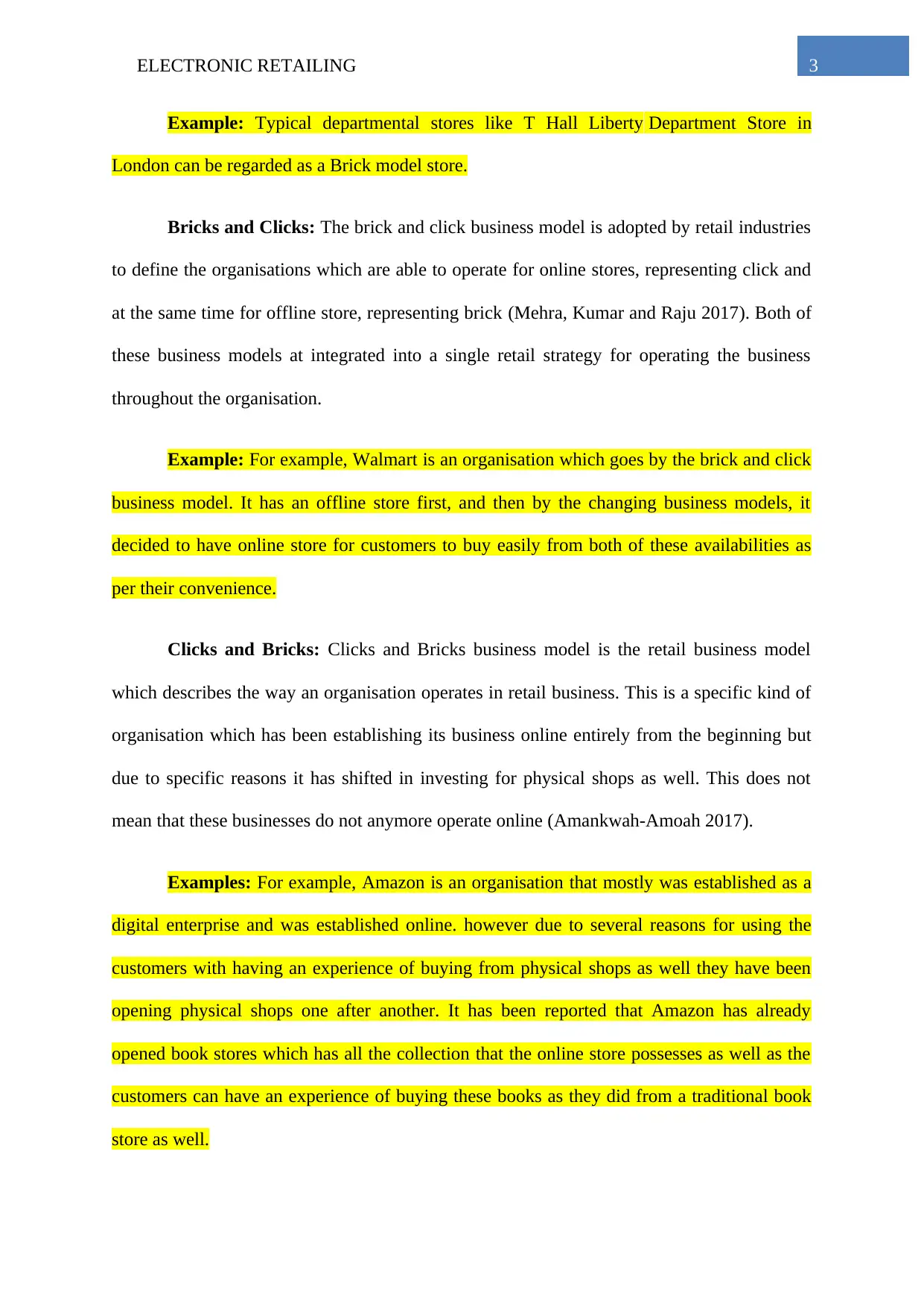
3ELECTRONIC RETAILING
Example: Typical departmental stores like T Hall Liberty Department Store in
London can be regarded as a Brick model store.
Bricks and Clicks: The brick and click business model is adopted by retail industries
to define the organisations which are able to operate for online stores, representing click and
at the same time for offline store, representing brick (Mehra, Kumar and Raju 2017). Both of
these business models at integrated into a single retail strategy for operating the business
throughout the organisation.
Example: For example, Walmart is an organisation which goes by the brick and click
business model. It has an offline store first, and then by the changing business models, it
decided to have online store for customers to buy easily from both of these availabilities as
per their convenience.
Clicks and Bricks: Clicks and Bricks business model is the retail business model
which describes the way an organisation operates in retail business. This is a specific kind of
organisation which has been establishing its business online entirely from the beginning but
due to specific reasons it has shifted in investing for physical shops as well. This does not
mean that these businesses do not anymore operate online (Amankwah-Amoah 2017).
Examples: For example, Amazon is an organisation that mostly was established as a
digital enterprise and was established online. however due to several reasons for using the
customers with having an experience of buying from physical shops as well they have been
opening physical shops one after another. It has been reported that Amazon has already
opened book stores which has all the collection that the online store possesses as well as the
customers can have an experience of buying these books as they did from a traditional book
store as well.
Example: Typical departmental stores like T Hall Liberty Department Store in
London can be regarded as a Brick model store.
Bricks and Clicks: The brick and click business model is adopted by retail industries
to define the organisations which are able to operate for online stores, representing click and
at the same time for offline store, representing brick (Mehra, Kumar and Raju 2017). Both of
these business models at integrated into a single retail strategy for operating the business
throughout the organisation.
Example: For example, Walmart is an organisation which goes by the brick and click
business model. It has an offline store first, and then by the changing business models, it
decided to have online store for customers to buy easily from both of these availabilities as
per their convenience.
Clicks and Bricks: Clicks and Bricks business model is the retail business model
which describes the way an organisation operates in retail business. This is a specific kind of
organisation which has been establishing its business online entirely from the beginning but
due to specific reasons it has shifted in investing for physical shops as well. This does not
mean that these businesses do not anymore operate online (Amankwah-Amoah 2017).
Examples: For example, Amazon is an organisation that mostly was established as a
digital enterprise and was established online. however due to several reasons for using the
customers with having an experience of buying from physical shops as well they have been
opening physical shops one after another. It has been reported that Amazon has already
opened book stores which has all the collection that the online store possesses as well as the
customers can have an experience of buying these books as they did from a traditional book
store as well.
Secure Best Marks with AI Grader
Need help grading? Try our AI Grader for instant feedback on your assignments.
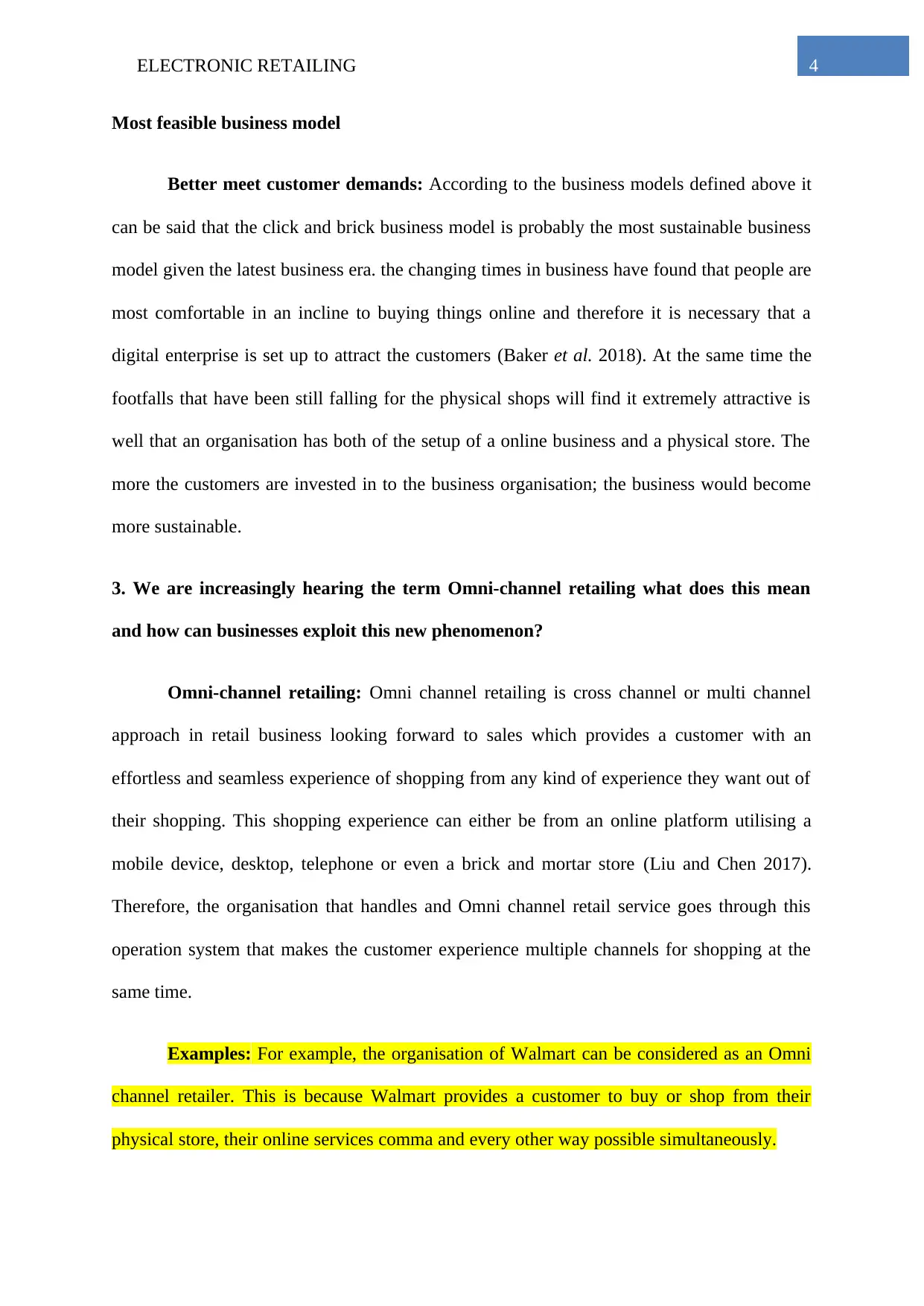
4ELECTRONIC RETAILING
Most feasible business model
Better meet customer demands: According to the business models defined above it
can be said that the click and brick business model is probably the most sustainable business
model given the latest business era. the changing times in business have found that people are
most comfortable in an incline to buying things online and therefore it is necessary that a
digital enterprise is set up to attract the customers (Baker et al. 2018). At the same time the
footfalls that have been still falling for the physical shops will find it extremely attractive is
well that an organisation has both of the setup of a online business and a physical store. The
more the customers are invested in to the business organisation; the business would become
more sustainable.
3. We are increasingly hearing the term Omni-channel retailing what does this mean
and how can businesses exploit this new phenomenon?
Omni-channel retailing: Omni channel retailing is cross channel or multi channel
approach in retail business looking forward to sales which provides a customer with an
effortless and seamless experience of shopping from any kind of experience they want out of
their shopping. This shopping experience can either be from an online platform utilising a
mobile device, desktop, telephone or even a brick and mortar store (Liu and Chen 2017).
Therefore, the organisation that handles and Omni channel retail service goes through this
operation system that makes the customer experience multiple channels for shopping at the
same time.
Examples: For example, the organisation of Walmart can be considered as an Omni
channel retailer. This is because Walmart provides a customer to buy or shop from their
physical store, their online services comma and every other way possible simultaneously.
Most feasible business model
Better meet customer demands: According to the business models defined above it
can be said that the click and brick business model is probably the most sustainable business
model given the latest business era. the changing times in business have found that people are
most comfortable in an incline to buying things online and therefore it is necessary that a
digital enterprise is set up to attract the customers (Baker et al. 2018). At the same time the
footfalls that have been still falling for the physical shops will find it extremely attractive is
well that an organisation has both of the setup of a online business and a physical store. The
more the customers are invested in to the business organisation; the business would become
more sustainable.
3. We are increasingly hearing the term Omni-channel retailing what does this mean
and how can businesses exploit this new phenomenon?
Omni-channel retailing: Omni channel retailing is cross channel or multi channel
approach in retail business looking forward to sales which provides a customer with an
effortless and seamless experience of shopping from any kind of experience they want out of
their shopping. This shopping experience can either be from an online platform utilising a
mobile device, desktop, telephone or even a brick and mortar store (Liu and Chen 2017).
Therefore, the organisation that handles and Omni channel retail service goes through this
operation system that makes the customer experience multiple channels for shopping at the
same time.
Examples: For example, the organisation of Walmart can be considered as an Omni
channel retailer. This is because Walmart provides a customer to buy or shop from their
physical store, their online services comma and every other way possible simultaneously.
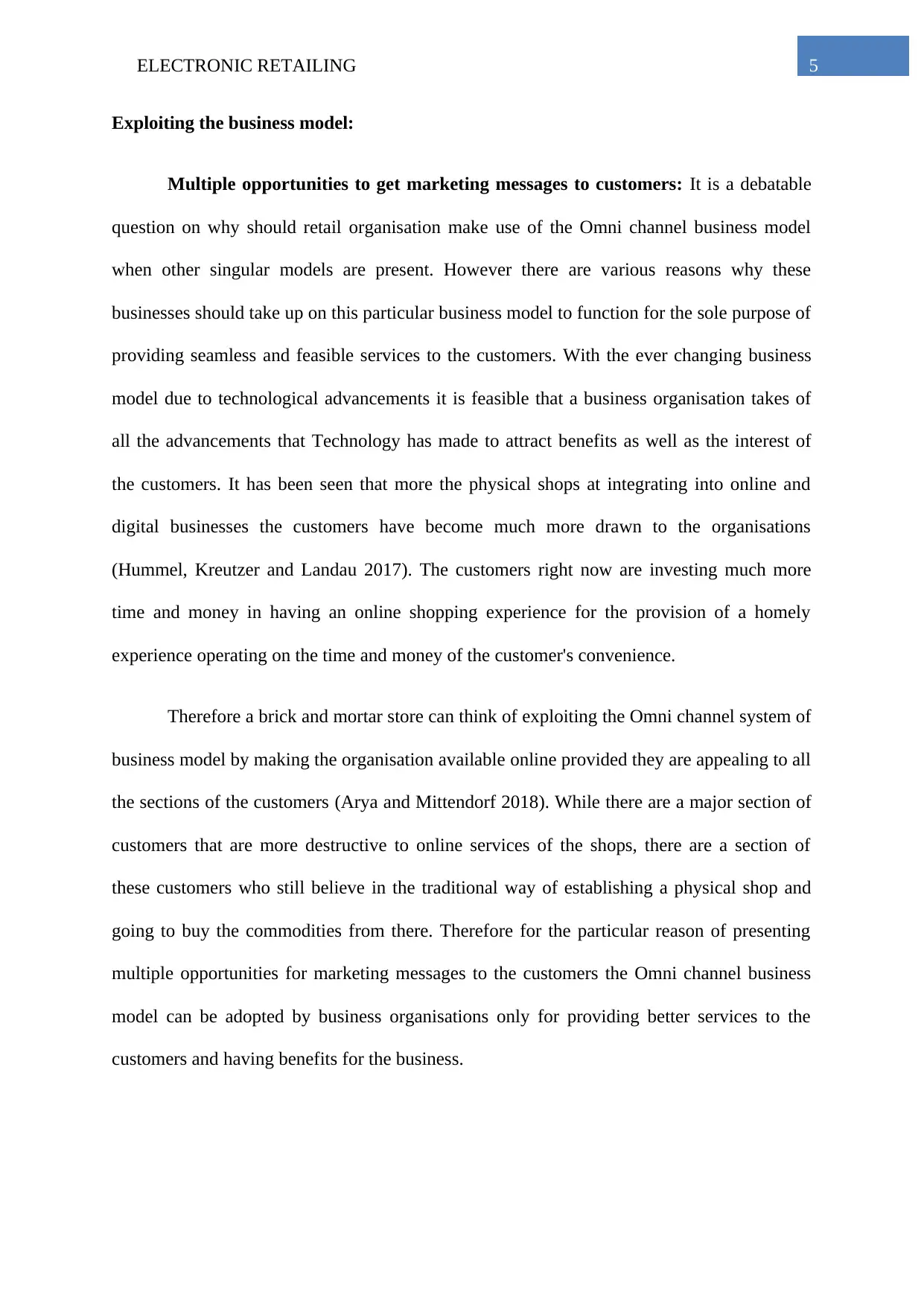
5ELECTRONIC RETAILING
Exploiting the business model:
Multiple opportunities to get marketing messages to customers: It is a debatable
question on why should retail organisation make use of the Omni channel business model
when other singular models are present. However there are various reasons why these
businesses should take up on this particular business model to function for the sole purpose of
providing seamless and feasible services to the customers. With the ever changing business
model due to technological advancements it is feasible that a business organisation takes of
all the advancements that Technology has made to attract benefits as well as the interest of
the customers. It has been seen that more the physical shops at integrating into online and
digital businesses the customers have become much more drawn to the organisations
(Hummel, Kreutzer and Landau 2017). The customers right now are investing much more
time and money in having an online shopping experience for the provision of a homely
experience operating on the time and money of the customer's convenience.
Therefore a brick and mortar store can think of exploiting the Omni channel system of
business model by making the organisation available online provided they are appealing to all
the sections of the customers (Arya and Mittendorf 2018). While there are a major section of
customers that are more destructive to online services of the shops, there are a section of
these customers who still believe in the traditional way of establishing a physical shop and
going to buy the commodities from there. Therefore for the particular reason of presenting
multiple opportunities for marketing messages to the customers the Omni channel business
model can be adopted by business organisations only for providing better services to the
customers and having benefits for the business.
Exploiting the business model:
Multiple opportunities to get marketing messages to customers: It is a debatable
question on why should retail organisation make use of the Omni channel business model
when other singular models are present. However there are various reasons why these
businesses should take up on this particular business model to function for the sole purpose of
providing seamless and feasible services to the customers. With the ever changing business
model due to technological advancements it is feasible that a business organisation takes of
all the advancements that Technology has made to attract benefits as well as the interest of
the customers. It has been seen that more the physical shops at integrating into online and
digital businesses the customers have become much more drawn to the organisations
(Hummel, Kreutzer and Landau 2017). The customers right now are investing much more
time and money in having an online shopping experience for the provision of a homely
experience operating on the time and money of the customer's convenience.
Therefore a brick and mortar store can think of exploiting the Omni channel system of
business model by making the organisation available online provided they are appealing to all
the sections of the customers (Arya and Mittendorf 2018). While there are a major section of
customers that are more destructive to online services of the shops, there are a section of
these customers who still believe in the traditional way of establishing a physical shop and
going to buy the commodities from there. Therefore for the particular reason of presenting
multiple opportunities for marketing messages to the customers the Omni channel business
model can be adopted by business organisations only for providing better services to the
customers and having benefits for the business.
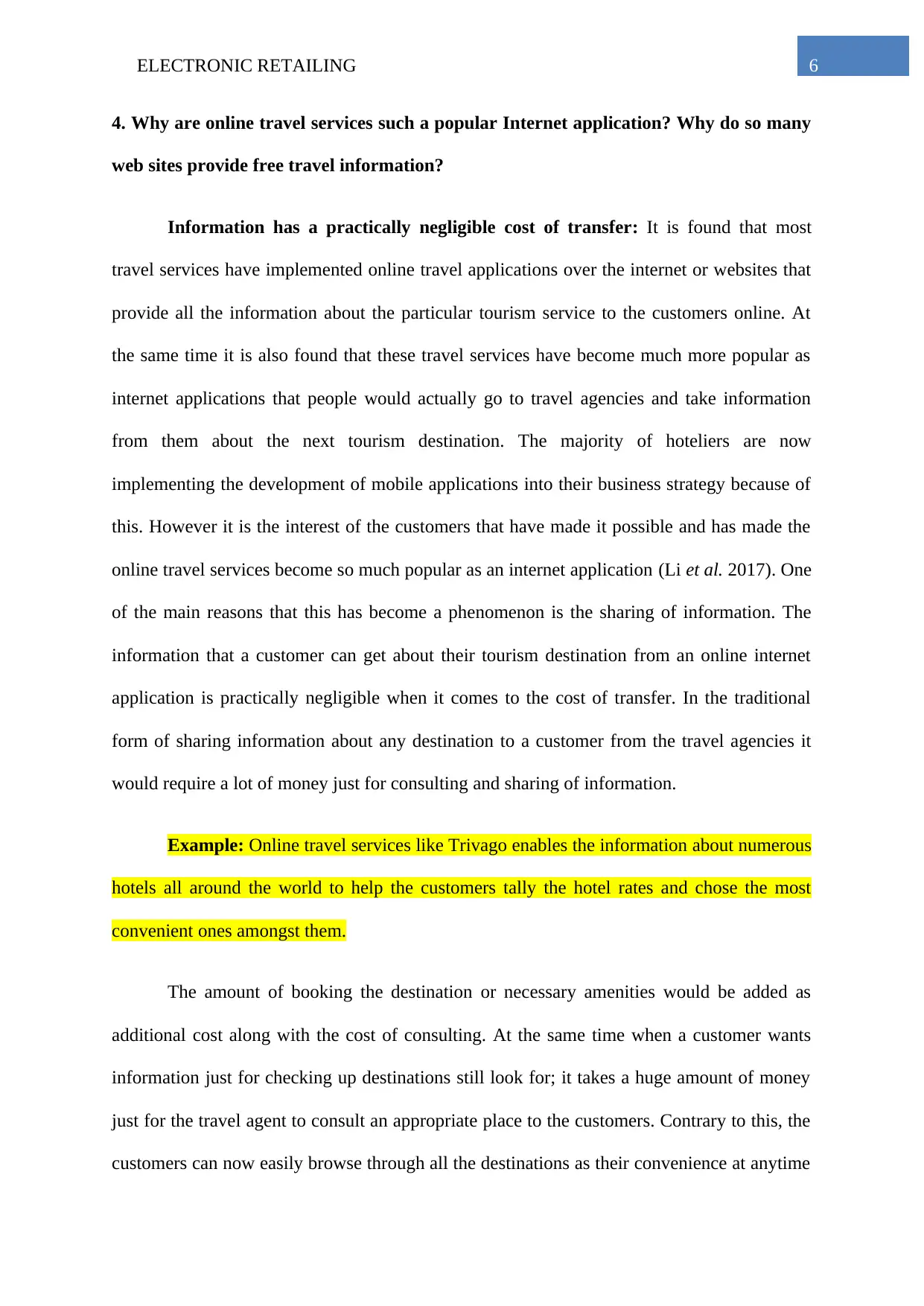
6ELECTRONIC RETAILING
4. Why are online travel services such a popular Internet application? Why do so many
web sites provide free travel information?
Information has a practically negligible cost of transfer: It is found that most
travel services have implemented online travel applications over the internet or websites that
provide all the information about the particular tourism service to the customers online. At
the same time it is also found that these travel services have become much more popular as
internet applications that people would actually go to travel agencies and take information
from them about the next tourism destination. The majority of hoteliers are now
implementing the development of mobile applications into their business strategy because of
this. However it is the interest of the customers that have made it possible and has made the
online travel services become so much popular as an internet application (Li et al. 2017). One
of the main reasons that this has become a phenomenon is the sharing of information. The
information that a customer can get about their tourism destination from an online internet
application is practically negligible when it comes to the cost of transfer. In the traditional
form of sharing information about any destination to a customer from the travel agencies it
would require a lot of money just for consulting and sharing of information.
Example: Online travel services like Trivago enables the information about numerous
hotels all around the world to help the customers tally the hotel rates and chose the most
convenient ones amongst them.
The amount of booking the destination or necessary amenities would be added as
additional cost along with the cost of consulting. At the same time when a customer wants
information just for checking up destinations still look for; it takes a huge amount of money
just for the travel agent to consult an appropriate place to the customers. Contrary to this, the
customers can now easily browse through all the destinations as their convenience at anytime
4. Why are online travel services such a popular Internet application? Why do so many
web sites provide free travel information?
Information has a practically negligible cost of transfer: It is found that most
travel services have implemented online travel applications over the internet or websites that
provide all the information about the particular tourism service to the customers online. At
the same time it is also found that these travel services have become much more popular as
internet applications that people would actually go to travel agencies and take information
from them about the next tourism destination. The majority of hoteliers are now
implementing the development of mobile applications into their business strategy because of
this. However it is the interest of the customers that have made it possible and has made the
online travel services become so much popular as an internet application (Li et al. 2017). One
of the main reasons that this has become a phenomenon is the sharing of information. The
information that a customer can get about their tourism destination from an online internet
application is practically negligible when it comes to the cost of transfer. In the traditional
form of sharing information about any destination to a customer from the travel agencies it
would require a lot of money just for consulting and sharing of information.
Example: Online travel services like Trivago enables the information about numerous
hotels all around the world to help the customers tally the hotel rates and chose the most
convenient ones amongst them.
The amount of booking the destination or necessary amenities would be added as
additional cost along with the cost of consulting. At the same time when a customer wants
information just for checking up destinations still look for; it takes a huge amount of money
just for the travel agent to consult an appropriate place to the customers. Contrary to this, the
customers can now easily browse through all the destinations as their convenience at anytime
Paraphrase This Document
Need a fresh take? Get an instant paraphrase of this document with our AI Paraphraser
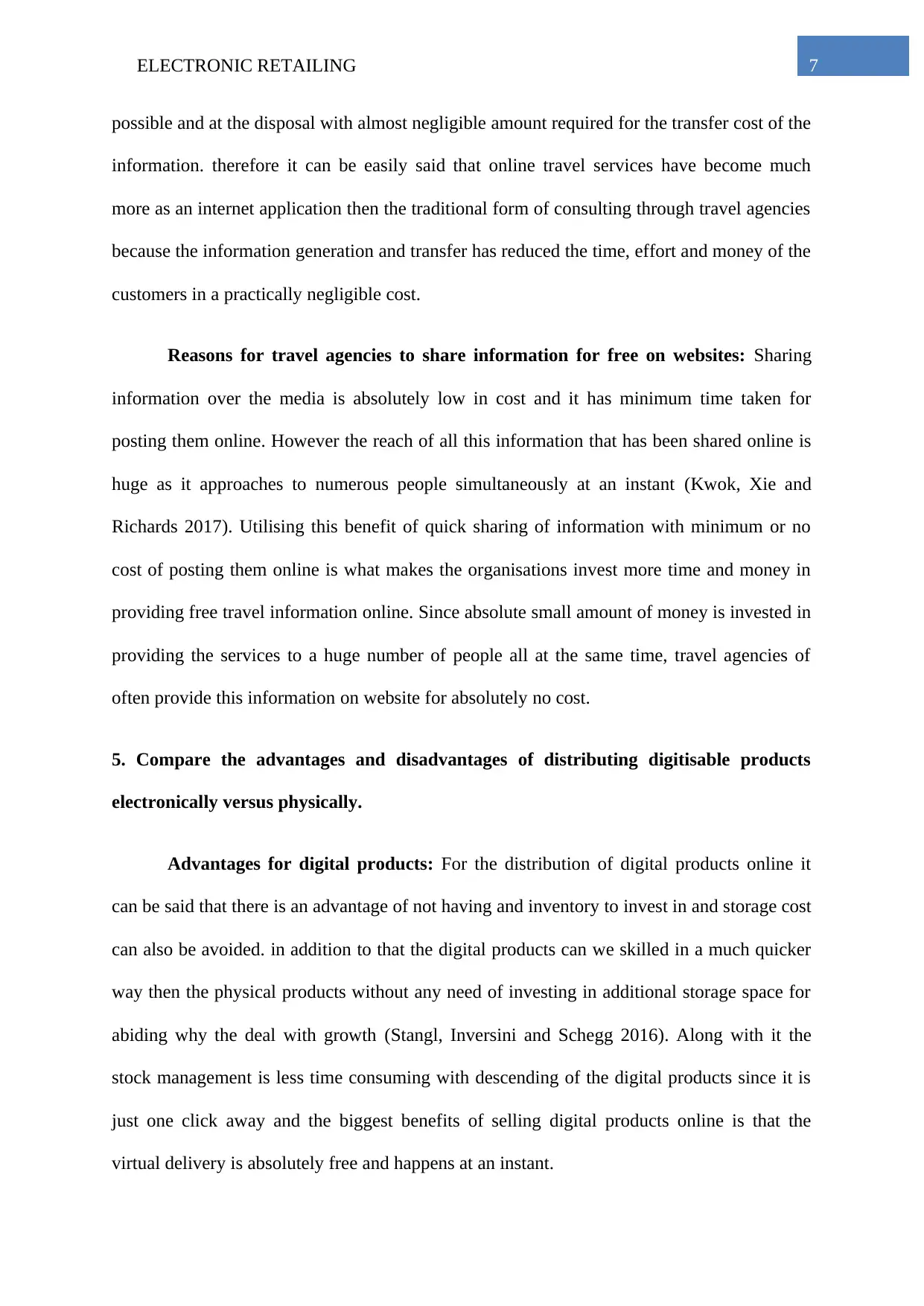
7ELECTRONIC RETAILING
possible and at the disposal with almost negligible amount required for the transfer cost of the
information. therefore it can be easily said that online travel services have become much
more as an internet application then the traditional form of consulting through travel agencies
because the information generation and transfer has reduced the time, effort and money of the
customers in a practically negligible cost.
Reasons for travel agencies to share information for free on websites: Sharing
information over the media is absolutely low in cost and it has minimum time taken for
posting them online. However the reach of all this information that has been shared online is
huge as it approaches to numerous people simultaneously at an instant (Kwok, Xie and
Richards 2017). Utilising this benefit of quick sharing of information with minimum or no
cost of posting them online is what makes the organisations invest more time and money in
providing free travel information online. Since absolute small amount of money is invested in
providing the services to a huge number of people all at the same time, travel agencies of
often provide this information on website for absolutely no cost.
5. Compare the advantages and disadvantages of distributing digitisable products
electronically versus physically.
Advantages for digital products: For the distribution of digital products online it
can be said that there is an advantage of not having and inventory to invest in and storage cost
can also be avoided. in addition to that the digital products can we skilled in a much quicker
way then the physical products without any need of investing in additional storage space for
abiding why the deal with growth (Stangl, Inversini and Schegg 2016). Along with it the
stock management is less time consuming with descending of the digital products since it is
just one click away and the biggest benefits of selling digital products online is that the
virtual delivery is absolutely free and happens at an instant.
possible and at the disposal with almost negligible amount required for the transfer cost of the
information. therefore it can be easily said that online travel services have become much
more as an internet application then the traditional form of consulting through travel agencies
because the information generation and transfer has reduced the time, effort and money of the
customers in a practically negligible cost.
Reasons for travel agencies to share information for free on websites: Sharing
information over the media is absolutely low in cost and it has minimum time taken for
posting them online. However the reach of all this information that has been shared online is
huge as it approaches to numerous people simultaneously at an instant (Kwok, Xie and
Richards 2017). Utilising this benefit of quick sharing of information with minimum or no
cost of posting them online is what makes the organisations invest more time and money in
providing free travel information online. Since absolute small amount of money is invested in
providing the services to a huge number of people all at the same time, travel agencies of
often provide this information on website for absolutely no cost.
5. Compare the advantages and disadvantages of distributing digitisable products
electronically versus physically.
Advantages for digital products: For the distribution of digital products online it
can be said that there is an advantage of not having and inventory to invest in and storage cost
can also be avoided. in addition to that the digital products can we skilled in a much quicker
way then the physical products without any need of investing in additional storage space for
abiding why the deal with growth (Stangl, Inversini and Schegg 2016). Along with it the
stock management is less time consuming with descending of the digital products since it is
just one click away and the biggest benefits of selling digital products online is that the
virtual delivery is absolutely free and happens at an instant.
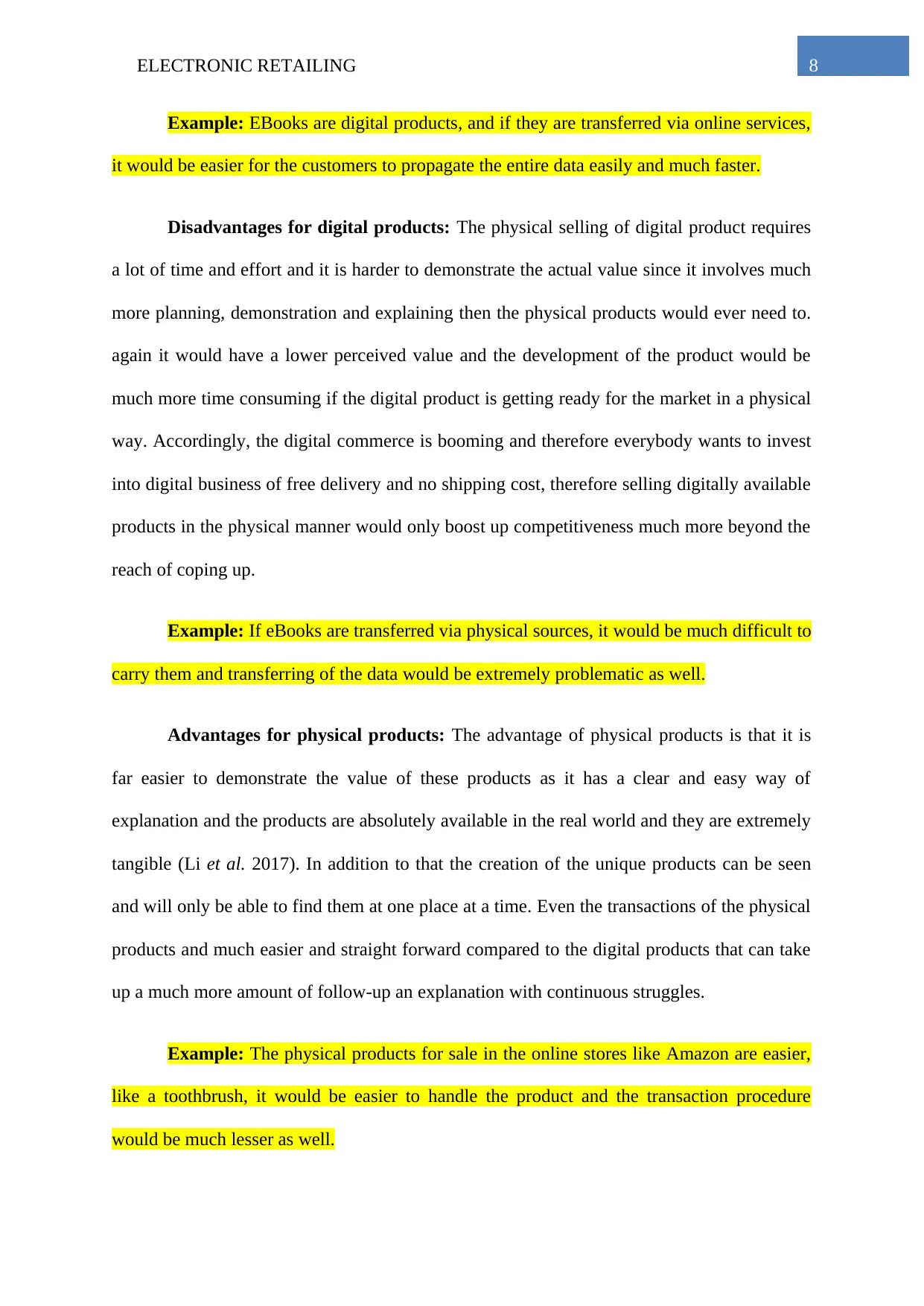
8ELECTRONIC RETAILING
Example: EBooks are digital products, and if they are transferred via online services,
it would be easier for the customers to propagate the entire data easily and much faster.
Disadvantages for digital products: The physical selling of digital product requires
a lot of time and effort and it is harder to demonstrate the actual value since it involves much
more planning, demonstration and explaining then the physical products would ever need to.
again it would have a lower perceived value and the development of the product would be
much more time consuming if the digital product is getting ready for the market in a physical
way. Accordingly, the digital commerce is booming and therefore everybody wants to invest
into digital business of free delivery and no shipping cost, therefore selling digitally available
products in the physical manner would only boost up competitiveness much more beyond the
reach of coping up.
Example: If eBooks are transferred via physical sources, it would be much difficult to
carry them and transferring of the data would be extremely problematic as well.
Advantages for physical products: The advantage of physical products is that it is
far easier to demonstrate the value of these products as it has a clear and easy way of
explanation and the products are absolutely available in the real world and they are extremely
tangible (Li et al. 2017). In addition to that the creation of the unique products can be seen
and will only be able to find them at one place at a time. Even the transactions of the physical
products and much easier and straight forward compared to the digital products that can take
up a much more amount of follow-up an explanation with continuous struggles.
Example: The physical products for sale in the online stores like Amazon are easier,
like a toothbrush, it would be easier to handle the product and the transaction procedure
would be much lesser as well.
Example: EBooks are digital products, and if they are transferred via online services,
it would be easier for the customers to propagate the entire data easily and much faster.
Disadvantages for digital products: The physical selling of digital product requires
a lot of time and effort and it is harder to demonstrate the actual value since it involves much
more planning, demonstration and explaining then the physical products would ever need to.
again it would have a lower perceived value and the development of the product would be
much more time consuming if the digital product is getting ready for the market in a physical
way. Accordingly, the digital commerce is booming and therefore everybody wants to invest
into digital business of free delivery and no shipping cost, therefore selling digitally available
products in the physical manner would only boost up competitiveness much more beyond the
reach of coping up.
Example: If eBooks are transferred via physical sources, it would be much difficult to
carry them and transferring of the data would be extremely problematic as well.
Advantages for physical products: The advantage of physical products is that it is
far easier to demonstrate the value of these products as it has a clear and easy way of
explanation and the products are absolutely available in the real world and they are extremely
tangible (Li et al. 2017). In addition to that the creation of the unique products can be seen
and will only be able to find them at one place at a time. Even the transactions of the physical
products and much easier and straight forward compared to the digital products that can take
up a much more amount of follow-up an explanation with continuous struggles.
Example: The physical products for sale in the online stores like Amazon are easier,
like a toothbrush, it would be easier to handle the product and the transaction procedure
would be much lesser as well.
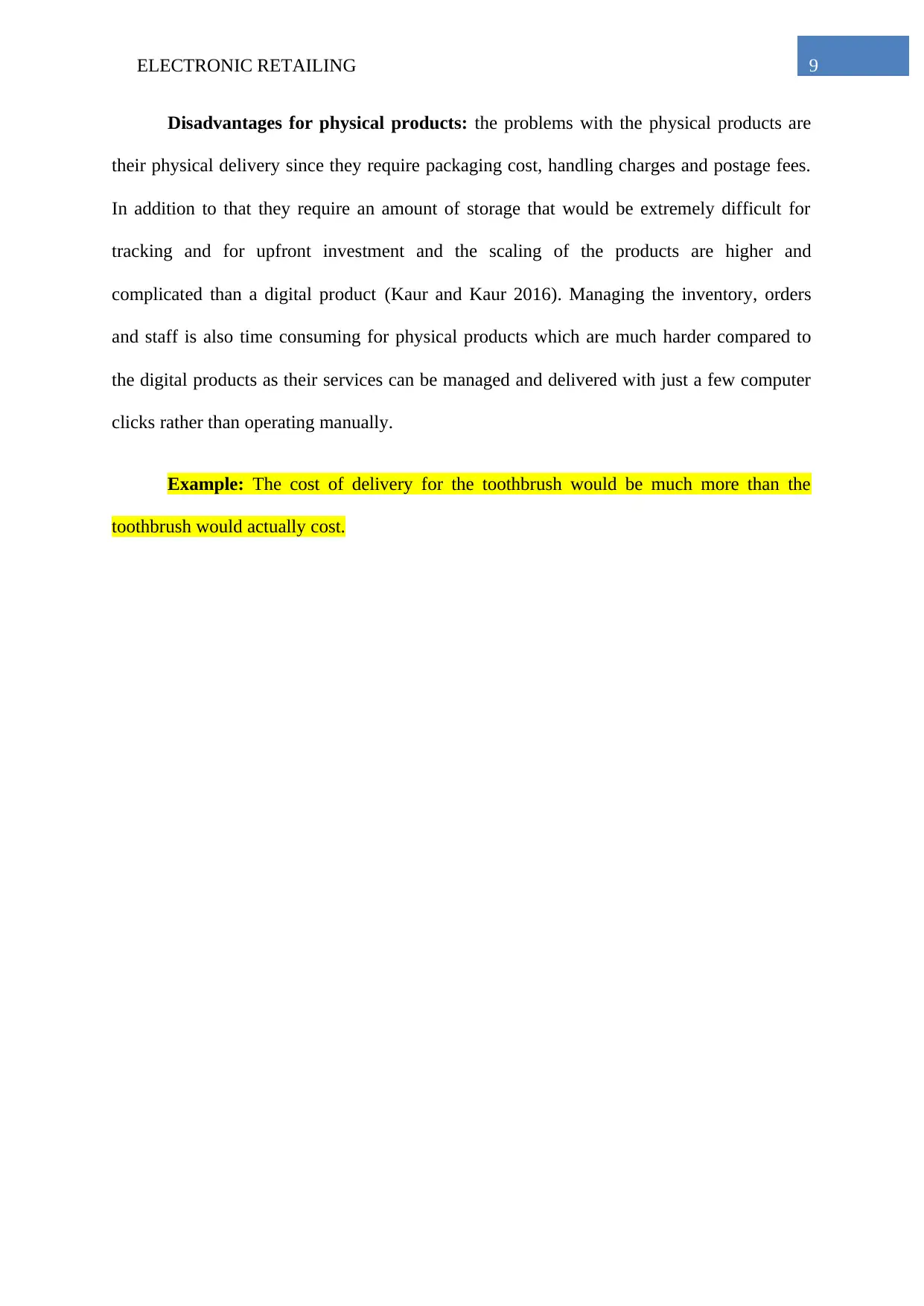
9ELECTRONIC RETAILING
Disadvantages for physical products: the problems with the physical products are
their physical delivery since they require packaging cost, handling charges and postage fees.
In addition to that they require an amount of storage that would be extremely difficult for
tracking and for upfront investment and the scaling of the products are higher and
complicated than a digital product (Kaur and Kaur 2016). Managing the inventory, orders
and staff is also time consuming for physical products which are much harder compared to
the digital products as their services can be managed and delivered with just a few computer
clicks rather than operating manually.
Example: The cost of delivery for the toothbrush would be much more than the
toothbrush would actually cost.
Disadvantages for physical products: the problems with the physical products are
their physical delivery since they require packaging cost, handling charges and postage fees.
In addition to that they require an amount of storage that would be extremely difficult for
tracking and for upfront investment and the scaling of the products are higher and
complicated than a digital product (Kaur and Kaur 2016). Managing the inventory, orders
and staff is also time consuming for physical products which are much harder compared to
the digital products as their services can be managed and delivered with just a few computer
clicks rather than operating manually.
Example: The cost of delivery for the toothbrush would be much more than the
toothbrush would actually cost.
Secure Best Marks with AI Grader
Need help grading? Try our AI Grader for instant feedback on your assignments.
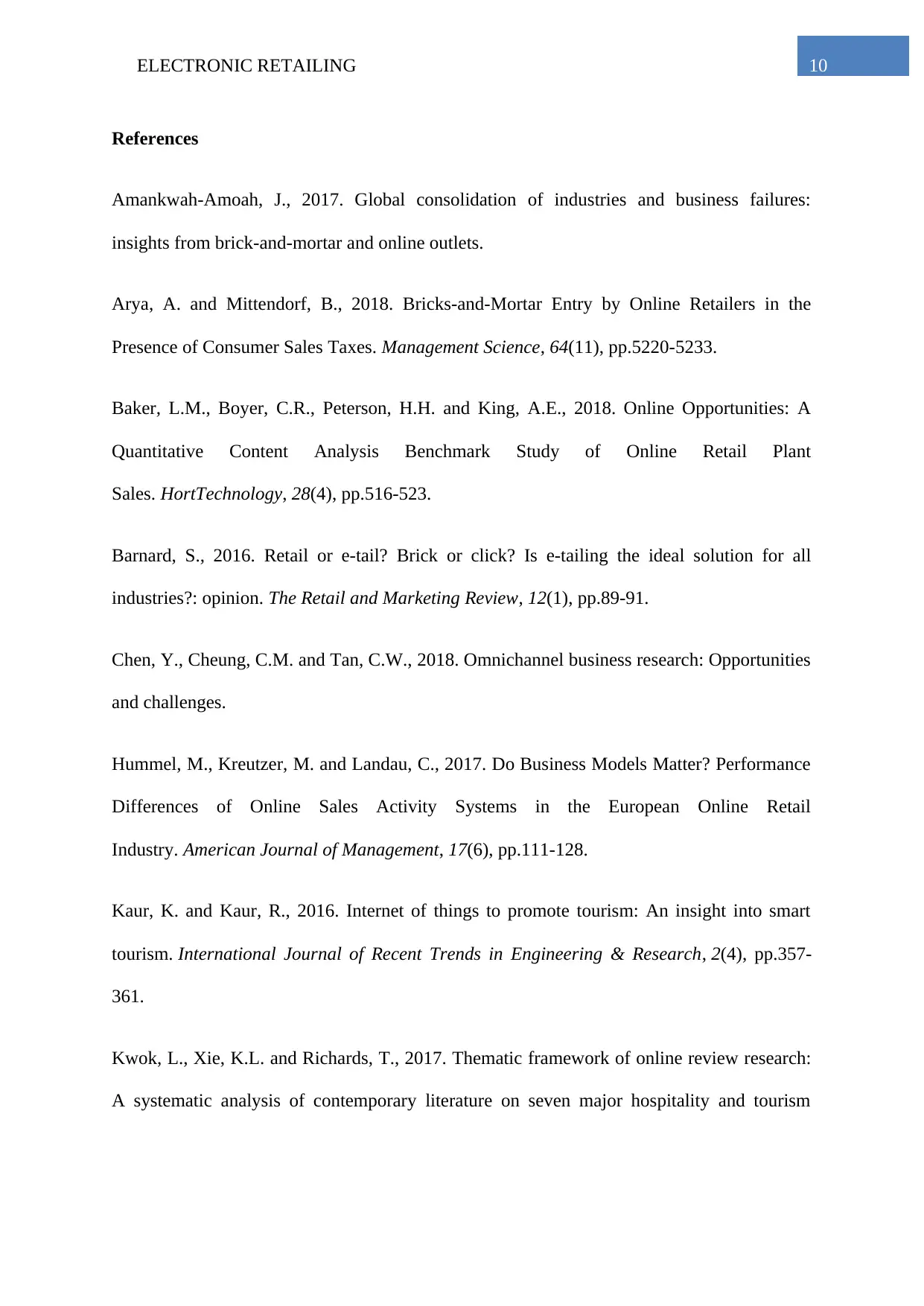
10ELECTRONIC RETAILING
References
Amankwah-Amoah, J., 2017. Global consolidation of industries and business failures:
insights from brick-and-mortar and online outlets.
Arya, A. and Mittendorf, B., 2018. Bricks-and-Mortar Entry by Online Retailers in the
Presence of Consumer Sales Taxes. Management Science, 64(11), pp.5220-5233.
Baker, L.M., Boyer, C.R., Peterson, H.H. and King, A.E., 2018. Online Opportunities: A
Quantitative Content Analysis Benchmark Study of Online Retail Plant
Sales. HortTechnology, 28(4), pp.516-523.
Barnard, S., 2016. Retail or e-tail? Brick or click? Is e-tailing the ideal solution for all
industries?: opinion. The Retail and Marketing Review, 12(1), pp.89-91.
Chen, Y., Cheung, C.M. and Tan, C.W., 2018. Omnichannel business research: Opportunities
and challenges.
Hummel, M., Kreutzer, M. and Landau, C., 2017. Do Business Models Matter? Performance
Differences of Online Sales Activity Systems in the European Online Retail
Industry. American Journal of Management, 17(6), pp.111-128.
Kaur, K. and Kaur, R., 2016. Internet of things to promote tourism: An insight into smart
tourism. International Journal of Recent Trends in Engineering & Research, 2(4), pp.357-
361.
Kwok, L., Xie, K.L. and Richards, T., 2017. Thematic framework of online review research:
A systematic analysis of contemporary literature on seven major hospitality and tourism
References
Amankwah-Amoah, J., 2017. Global consolidation of industries and business failures:
insights from brick-and-mortar and online outlets.
Arya, A. and Mittendorf, B., 2018. Bricks-and-Mortar Entry by Online Retailers in the
Presence of Consumer Sales Taxes. Management Science, 64(11), pp.5220-5233.
Baker, L.M., Boyer, C.R., Peterson, H.H. and King, A.E., 2018. Online Opportunities: A
Quantitative Content Analysis Benchmark Study of Online Retail Plant
Sales. HortTechnology, 28(4), pp.516-523.
Barnard, S., 2016. Retail or e-tail? Brick or click? Is e-tailing the ideal solution for all
industries?: opinion. The Retail and Marketing Review, 12(1), pp.89-91.
Chen, Y., Cheung, C.M. and Tan, C.W., 2018. Omnichannel business research: Opportunities
and challenges.
Hummel, M., Kreutzer, M. and Landau, C., 2017. Do Business Models Matter? Performance
Differences of Online Sales Activity Systems in the European Online Retail
Industry. American Journal of Management, 17(6), pp.111-128.
Kaur, K. and Kaur, R., 2016. Internet of things to promote tourism: An insight into smart
tourism. International Journal of Recent Trends in Engineering & Research, 2(4), pp.357-
361.
Kwok, L., Xie, K.L. and Richards, T., 2017. Thematic framework of online review research:
A systematic analysis of contemporary literature on seven major hospitality and tourism
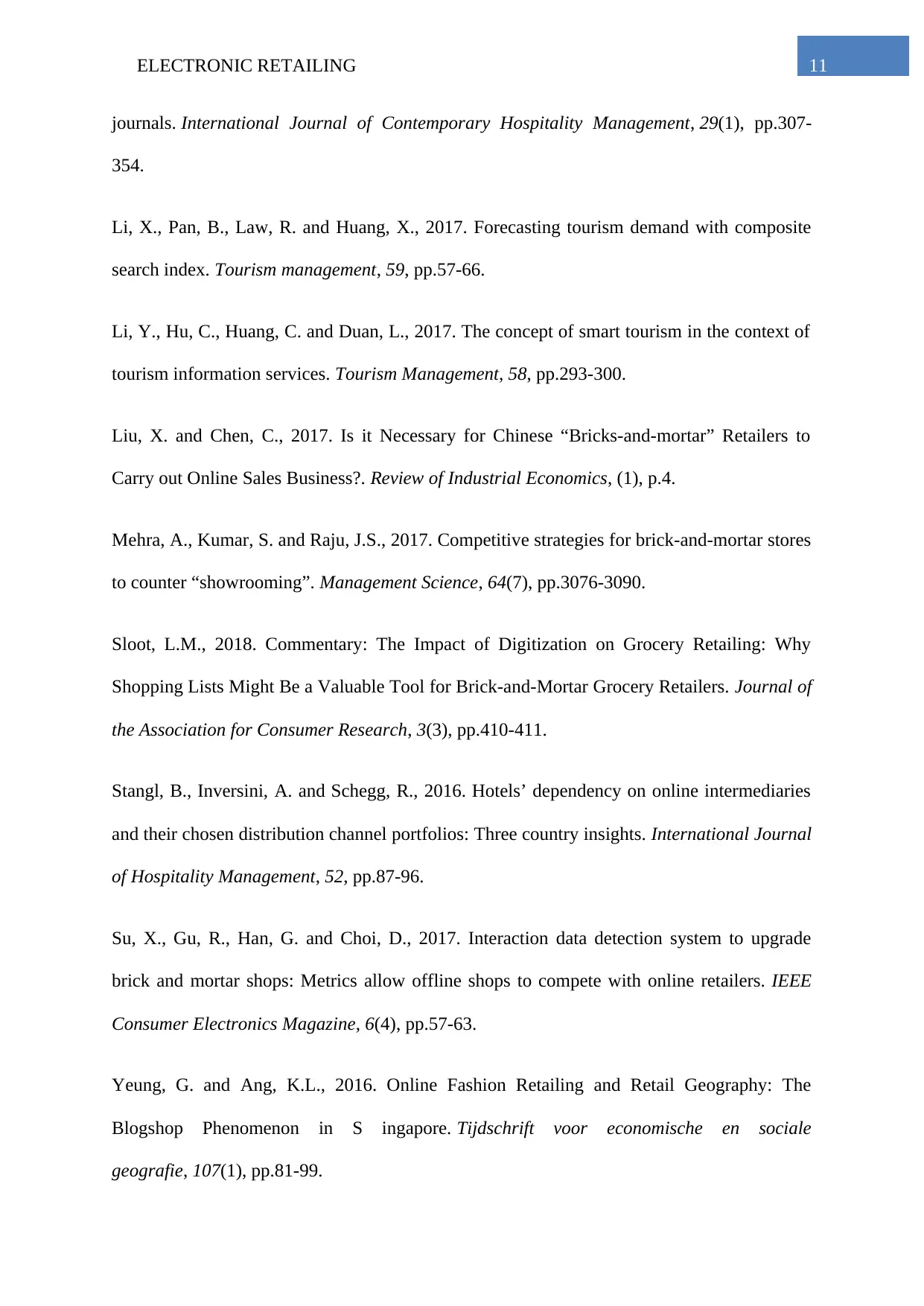
11ELECTRONIC RETAILING
journals. International Journal of Contemporary Hospitality Management, 29(1), pp.307-
354.
Li, X., Pan, B., Law, R. and Huang, X., 2017. Forecasting tourism demand with composite
search index. Tourism management, 59, pp.57-66.
Li, Y., Hu, C., Huang, C. and Duan, L., 2017. The concept of smart tourism in the context of
tourism information services. Tourism Management, 58, pp.293-300.
Liu, X. and Chen, C., 2017. Is it Necessary for Chinese “Bricks-and-mortar” Retailers to
Carry out Online Sales Business?. Review of Industrial Economics, (1), p.4.
Mehra, A., Kumar, S. and Raju, J.S., 2017. Competitive strategies for brick-and-mortar stores
to counter “showrooming”. Management Science, 64(7), pp.3076-3090.
Sloot, L.M., 2018. Commentary: The Impact of Digitization on Grocery Retailing: Why
Shopping Lists Might Be a Valuable Tool for Brick-and-Mortar Grocery Retailers. Journal of
the Association for Consumer Research, 3(3), pp.410-411.
Stangl, B., Inversini, A. and Schegg, R., 2016. Hotels’ dependency on online intermediaries
and their chosen distribution channel portfolios: Three country insights. International Journal
of Hospitality Management, 52, pp.87-96.
Su, X., Gu, R., Han, G. and Choi, D., 2017. Interaction data detection system to upgrade
brick and mortar shops: Metrics allow offline shops to compete with online retailers. IEEE
Consumer Electronics Magazine, 6(4), pp.57-63.
Yeung, G. and Ang, K.L., 2016. Online Fashion Retailing and Retail Geography: The
Blogshop Phenomenon in S ingapore. Tijdschrift voor economische en sociale
geografie, 107(1), pp.81-99.
journals. International Journal of Contemporary Hospitality Management, 29(1), pp.307-
354.
Li, X., Pan, B., Law, R. and Huang, X., 2017. Forecasting tourism demand with composite
search index. Tourism management, 59, pp.57-66.
Li, Y., Hu, C., Huang, C. and Duan, L., 2017. The concept of smart tourism in the context of
tourism information services. Tourism Management, 58, pp.293-300.
Liu, X. and Chen, C., 2017. Is it Necessary for Chinese “Bricks-and-mortar” Retailers to
Carry out Online Sales Business?. Review of Industrial Economics, (1), p.4.
Mehra, A., Kumar, S. and Raju, J.S., 2017. Competitive strategies for brick-and-mortar stores
to counter “showrooming”. Management Science, 64(7), pp.3076-3090.
Sloot, L.M., 2018. Commentary: The Impact of Digitization on Grocery Retailing: Why
Shopping Lists Might Be a Valuable Tool for Brick-and-Mortar Grocery Retailers. Journal of
the Association for Consumer Research, 3(3), pp.410-411.
Stangl, B., Inversini, A. and Schegg, R., 2016. Hotels’ dependency on online intermediaries
and their chosen distribution channel portfolios: Three country insights. International Journal
of Hospitality Management, 52, pp.87-96.
Su, X., Gu, R., Han, G. and Choi, D., 2017. Interaction data detection system to upgrade
brick and mortar shops: Metrics allow offline shops to compete with online retailers. IEEE
Consumer Electronics Magazine, 6(4), pp.57-63.
Yeung, G. and Ang, K.L., 2016. Online Fashion Retailing and Retail Geography: The
Blogshop Phenomenon in S ingapore. Tijdschrift voor economische en sociale
geografie, 107(1), pp.81-99.
1 out of 12
Related Documents
Your All-in-One AI-Powered Toolkit for Academic Success.
+13062052269
info@desklib.com
Available 24*7 on WhatsApp / Email
![[object Object]](/_next/static/media/star-bottom.7253800d.svg)
Unlock your academic potential
© 2024 | Zucol Services PVT LTD | All rights reserved.





